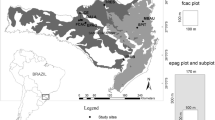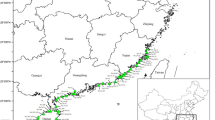Abstract
Phyllostachys edulis, one of the most dominant bamboo species with the leptomorph rhizome system, has been asexually expanding its range into adjacent natural forest sites by shooting new culms. The resulting ecological problems include simplification of stand structure and decline in the species diversity of local flora. In this study, the genetic diversity of P. edulis for the entire distribution range from Japan to China was analyzed using 16 microsatellite markers. Among these, 12 loci were fixed by a single allele, whereas only two alleles were detected for each of the remaining 4 loci; all adult samples shared the same genotype at all loci including the four heterozygous loci. These observations indicate that all current samples from Japan and China comprise an identical clone. The clone is distributed over more than 2,800 km with an estimated biomass of approximately 6.6 × 1011 kg, which is exceptionally large. Among seedlings from flowering events in 2005 and 2006, 20 different genets were generated by recombination through selfing of a single flowering genet. Predominance of a single clone in the wild and a diverse composition of genets among seedlings suggest that the intermittent flowering of P. edulis in the wild has produced a variety of clones through recombination. However, the resulting seedlings cannot compete with other tree species or adult P. edulis, and almost all adult P. edulis growing in Japan and China likely propagated through vegetative reproduction of a single clone by human transplantation, and subsequently expanded into adjacent forest sites by shooting young sprouts. The relatively small size of the flowering area and rapid culm reproduction has led to the stability of P. edulis communities. However, the low genetic diversity is an important consideration for the long-term management of this prevailing bamboo species.

Similar content being viewed by others

References
Ando H, Kaneko S, Suzuki H, Horikoshi K, Takano H, Ogawa H, Isagi Y (2011) Genetic diversity of the Japanese wood pigeon, Columba janthina, endemic to islands of East Asia, estimated by newly developed microsatellite markers. Zool Sci 28:891–896
Ando H, Ogawa H, Kaneko S, Takano H, Seki SI, Suzuki H, Horikoshi K, Isagi Y (2014) Genetic structure of the critically endangered Red-headed Wood Pigeon Columba janthina nitens and its implications for the management of threatened island populations. Ibis 156:153–164
Arnaud-Haond S, Duarte CM, Diaz-Almela E, Marba N, Sintes T, Serra EA (2012) Implications of extreme life span in clonal organisms: millenary clones in meadows of the threatened seagrass Posidonia oceanica. PLoS One 7:e30454
Chen X, Zhang X, Zhang Y, Booth T, He X (2009) Changes of carbon stocks in bamboo stands in China during 100 years. For Ecol Manag 258:1489–1496
Dlugosch KM, Parker IM (2008) Founding events in species invasions: genetic variation, adaptive evolution, and the role of multiple introductions. Mol Ecol 17:431–449
Forestry Agency (2013) Annual report on forest and forestry in Japan
Franklin DC, Kaneko S, Yamasaki N, Isagi Y (2008) Some wild bamboo clumps contain more than one genet. Aust J Bot 56:433–436
Fu J (2001) Chinese moso bamboo: its importance. Bamboo 22:5–7
Fukushima K, Usui N, Ogawa R, Tokuchi N (2014) Impacts of moso bamboo (Phyllostachys pubescens) invasion on dry matter, and carbon and nitrogen stocks in a broad-leaved secondary forest located in Kyoto, western Japan. Plant Species Biol. doi:10.1111/1442-1984.12066
Grant MC, Mitton JB, Linhart YB (1992) Even larger organisms. Nature 360:216
Hodkinson TR, Renvoize SA, Chonghaile GN, Stapleton CMA, Chase MW (2000) A comparison of ITS nuclear rDNA sequences data and AFLP markers for phylogenetic studies in Phyllostachys (Bambusoideae, Poaceae). J Plant Res 113:259–269
Isagi Y, Torii A (1997) Range expansion and its mechanisms in a naturalized bamboo species, Phyllostachys pubescens, in Japan. J Sustain For 6:127–141
Isagi Y, Kawahara T, Kamo K, Ito H (1997) Net production and carbon cycling in a bamboo Phyllostachys pubescens stand. Plant Ecol 130:41–52
Isagi Y, Shimada K, Kushima H, Tanaka N, Nagao A, Ishikawa T, Onodera H, Watanabe S (2004) Clonal structure and flowering traits of a bamboo [Phyllostachys pubescens (Mazel) Ohwi] stand grown from a simultaneous flowering as revealed by AFLP analysis. Mol Ecol 13:2017–2021
Janzen DH (1976) Why bamboos wait so long to flower. Annu Rev Ecol Syst 7:347–391
Kaneko S, Franklin DC, Yamasaki N, Isagi Y (2008) Development of microsatellite markers for Bambusa arnhemica (Poaceae: Bambuseae), a bamboo endemic to northern Australia. Conserv Genet 9:1311–1313
Kaneko S, Kondo T, Isagi Y (2011) Development of microsatellite markers for the northern Australian endemic fan palm Livistona rigida (Arecaceae), with cross-amplification in the five related species. Conserv Genet Resour 3:697–699
Keeley JE, Bond WJ (1999) Mast flowering and semelparity in bamboos: the bamboo fire cycle hypothesis. Am Nat 154:383–391
Kitamura K, Kawahara T (2009) Clonal identification by microsatellite loci in sporadic flowering of a dwarf bamboo species, Sasa cernua. J Plant Res 122:299–304
Kitamura S, Murata G (1979) Coloured illustrations of woody plants of Japan II. Hoikusha, Osaka (in Japanese)
Kondo T, Crisp MD, Linde C, Bowman DMJS, Kawamura K, Kaneko S, Isagi Y (2012) Not an ancient relic: the endemic Livistona palms of arid central Australia could have been introduced by humans. Proc Biol Sci 279:2652–2661
Lai C, Hsiao JY (1997) Genetic variation of Phyllostachys pubescens (Bambusoideae, Poaceae) in Taiwan based on DNA polymorphisms. Bot Bull Acad Sin 38:145–152
Lian C, Hogetsu T (2002) Development of microsatellite markers in black locust (Robinia pseudoacacia) using a dual-supression-PCR technique. Mol Ecol Notes 2:211–213
Lian CL, Wadud MA, Geng QF, Shimatani K, Hogetsu T (2006) An improved technique for isolating codominant compound microsatellite markers. J Plant Res 119:415–417
McClure FA (1966) The bamboos. Harvard University Press, Massachusetts
Mertens B, Hua L, Belcher B, Ruiz-Pérez M, Maoyi F, **aosheng Y (2008) Spatial patterns and processes of bamboo expansion in Southern China. Appl Geogr 28:16–31
Milligan B (1992) Plant DNA isolation. In: Hoelzel AR (ed) Molecular genetic analysis of populations: a practical approach. IRL, Oxford University Press, Oxford
Miyazaki Y, Ohnishi N, Takafumi H, Hiura T (2009) Genets of dwarf bamboo do not die after one flowering event: evidence from genetic structure and flowering pattern. J Plant Res 122:523–528
Nagao A, Ishikawa T (1998) Simultaneous flowering of Phyllostachys pubescens grown from seeds at Forestry and Forest Products Research Institute (in Japanese). For Pests 47:11–14
Nakashizuka T (1988) Regeneration of Beech (Fagus crenata) after the simultaneous death of undergrowing dwarf bamboo (Sasa kurilensis). Ecol Res 3:21–35
Ohrnberger D (1999) The bamboos of the world: annotated nomenclature and literature of the species and the higher and lower taxa. Elsevier Science, Amsterdam
Peng Z, Lu T, Li L, Liu X, Gao Z, Hu T, Yang X, Feng Q, Guan J, Weng Q, Fan D, Zhu C, Lu Y, Han B, Jiang Z (2010) Genome-wide characterization of the biggest grass, bamboo, based on 10,608 putative full-length cDNA sequences. BMC Plant Biol 10:116
Rozen S, Skaletsky H (2000) Primer3 on the WWW for general users and for biologist programmers. Methods Mol Biol 132:365–386
Smith ML, Bruhn JN, Anderson JB (1992) The fungus Armillaria bulbosa is among the largest and oldest living organisms. Nature 356:428–431
Song X, Zhou G, Jiang H, Yu S, Fu J, Li W, Wang W, Ma Z, Peng C (2011) Carbon sequestration by Chinese bamboo forests and their ecological benefits: assessment of potential, problems, and future challenges. Environ Rev 19:418–428
Suyama Y, Obayashi K, Hayashi I (2000) Clonal structure in a dwarf bamboo (Sasa senanensis) population inferred from amplified fragment length polymorphism (AFLP) fingerprints. Mol Ecol 9:901–906
Suzuki S (1978) Index to Japanese Bambusaceae. Gakken, Tokyo
Uchimura E (1978) Ecological studies on cultivation of tropical bamboo forest in the Philippines. Bull For For Prod Res Inst 301:79–118
Ueda K (1960) Studies on the physiology of bamboo with reference to practical application. Bull Kyoto Univ For 30:1–169
Watanabe M, Ueda K, Manabe I, Akai T (1982) Flowering, seeding, germination, and flowering periodicity of Phyllostachys pubescens. J Jap For Soc 64:107–111
Yoshikawa N, Kaneko S, Kuwabara K, Okumura N, Matsui M, Isagi Y (2011) Development of microsatellite markers for the two giant Salamander species (Andrias japonicus and A. davidianus). Curr Herpetol 30:177–180
Acknowledgments
We thank F. Iwamatsu, M. Kawaji, Y. Ohta, M. Mabuchi, W. Muramatsu, N. Usui, J. Wada for sampling leaf materials of P. edulis. This work was partly supported by Sasakawa Scientific Research Grant from The Japan Science Society and the ESPEC Foundation for Global Environment Research and Technology (ESPEC Prize for the Encouragement of Environmental Studies).
Author information
Authors and Affiliations
Corresponding author
Ethics declarations
Conflict of interest
Keitaro Fukushima has received research grants from The Japan Science Society and ESPEC Corporation.
Electronic supplementary material
Below is the link to the electronic supplementary material.
Rights and permissions
About this article
Cite this article
Isagi, Y., Oda, T., Fukushima, K. et al. Predominance of a single clone of the most widely distributed bamboo species Phyllostachys edulis in East Asia. J Plant Res 129, 21–27 (2016). https://doi.org/10.1007/s10265-015-0766-z
Received:
Accepted:
Published:
Issue Date:
DOI: https://doi.org/10.1007/s10265-015-0766-z



